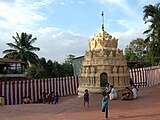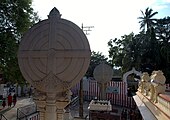Gavi Gangadhareshwara Temple
| Gavi Gangadhareshwara Temple | |
|---|---|
 A Trident of Lord Shiva outside the Gavi Gangadhareshwara temple at Bengaluru. | |
| Religion | |
| Affiliation | Hinduism |
| District | Bengaluru |
| Deity | Shiva as Gavi Gangadhareshwara |
| Festivals | Maha Shivaratri, Makara Sankranti |
| Location | |
| Location | Gavipura |
| State | Karnataka |
| Country | India |
| Geographic coordinates | 12°56′53.5″N 77°33′46.8″E / 12.948194°N 77.563000°E |
| Architecture | |
| Type | Indian rock-cut architecture |
| Completed | 16th century AD |
Gavi Gangadhareshwara Temple, or Sri Gangaadhareshwara, also Gavipura Cave Temple, an example of Indian rock-cut architecture, is located in Bengaluru in the state of Karnataka in India. The temple is famous for its mysterious stone discs in the forecourt and the exact planning allowing the sun to shine on the shrine during certain time of the year. It was built in the 16th century by Kempe Gowda I, the founder of the city.[1]
Temple history
This cave temple dedicated to Shiva. It is believed to have been built by Gautama Maharishi and Bharadwaja Muni in the Vedic period. It was later renovated in the 16th century AD by Kempe Gowda, the founder of Bengaluru.
One of the oldest temples in Bengaluru, Gavi Gangadhareshwara temple was built by Kempe Gowda in recognition after being released from a prison term of five years by Rama Raya. The temple Gavi is an architectural marvel that attracts the faithful by the hordes.
Temple architecture
Built in a natural cave in Gavipuram, the temple is dedicated to Lord Shiva and cut into a monolithic stone. The courtyard of the temple contains several monolithic sculptures. The main attractions of Gavi Gangadhareshvara temple are two granite pillars that support the giant disk of the sun and moon, and two pillars having several carvings of Nandi in a sitting posture at the top.[2]: 1632 The temple is also known for its four monolithic pillars, representing Damaru, Trishul and two large circular discs on the patio.
Two paintings dated 1 May 1792 AD by Thomas and William Daniell brothers shows that the temple has gone through some construction work with new walls and enclosures.[2]: 1635
Deities inside the Temple
The temple complex has numerous shrines for various detities in addition to the main deity Gavi Gangadhareswara.
- Parvati Devi
- Vinayaka
- Subramanya
- Gautama Maharishi
- Bharadwaja Muni
- Chandikeswara
- Uma Maheswara
- Vallabha Ganapathi
- Durga Devi
- Agni Deva
- Sapthamatrikas
- Dakshinamurthy
- Kala Bhairava
- Veerabhadra
- Lakshmi Narayana
- Surya and Chandra
- Ayyappa
- Anjaneya
- Mahaganapati
- Subramanya with Valli and Devasena
- Navagrahas
Special aspects of the Temple
Curative effects
The idol of Agnimurthi inside the temple has two heads, seven hands and three legs. It is believed that worship of the deity would cure defects of the eye.
Illumination of sanctum by the Sun
On the occasion of Makar Sankranti, the temple witnesses a unique phenomenon in the evening where sunlight passes through an arc between the horns of Nandi and falls directly on the linga inside the cave and illuminating the interior idol for an hour.[3] Lakhs of devotees come in mid January every year on Makar sankranti day to this cave temple.
Comparison of contemporary structures and earlier drawings by Thomas Daniell and William Daniell show that earlier the temple had fewer structures and the Sun illuminated the shrine in summer and winter solstice.[4][5][2] Of late, the Sun illuminates Shivalinga two times per year - from 13 to 16 January in late afternoons and from 26 November to 2 December.[2]: 1636
Tunnel from temple
People believe that there is a tunnel which may lead to Kashi. However, it is believed that two men named Nishant and Prem went into the tunnel and never returned.
Protected temple
The temple shrine is a protected monument under the Karnataka Ancient and Historical Monuments, and Archaeological Sites and Remains Act 1961.[6]
Gallery
-
Temple's front entrance
-
Roof top of the temple
-
Temple yard with monolithic sculptures
-
Another view of the roof top of the temple
-
Temple's rear entrance
Vintage Paintings
The temple saw numerous colonial artists painting different scenes over the years.
-
A painting of the temple by Thomas Daniell in 1792.
-
A painting of the temple by James Hunter, published posthumously in 1804.
-
A painting depicting the Harihara temple and great stone umbrella on the Harihararayana Gudda (hill) in 1792.
-
View from the Hepern House, Bangalore (Campbell, 1839)
-
A painting by Lieutenant Colonel J B MacGeorge titled "The Umbrella Temple" in 1917.
Nearby holy places
- Gosaayi Math
- Samadhi of yogi Bjt Narayan Maharaj - Located just behind the temple.
- Sri Bande Mahakali Temple
See also
Notes
- ^ Shastry, Vyasa (25 February 2017). "The mysteries of Bengaluru's famed Gavi Gangadhareshwara temple". Livemint. Retrieved 2 March 2017.
- ^ a b c d "Astronomical Significance of the Gavi Gangadhareshwara temple in Bangalore" (PDF). Current Science, Vol.95, No. 11, 10 December 2008. Retrieved 18 June 2010.
- ^ "Gavi Gangadhareshwara Temple at Bangalore(Karnataka)". Retrieved 13 September 2006.
- ^ "A stellar wonder". Deccan Herald. 8 January 2018. Retrieved 5 August 2019.
- ^ "IIACD | Gavi Gangadhareshwara Cave Temple and Vernacular Dwellings of Gavipuram: A Pilot Study". www.iiacd.org. Retrieved 5 August 2019.
- ^ "Gavi Gangadhareshwara Temple, Bangalore".
Further reading
- Hardy, Adam. Indian Temple Architecture: Form and Transformation. New Delhi. ISBN 8170173124.
External links












